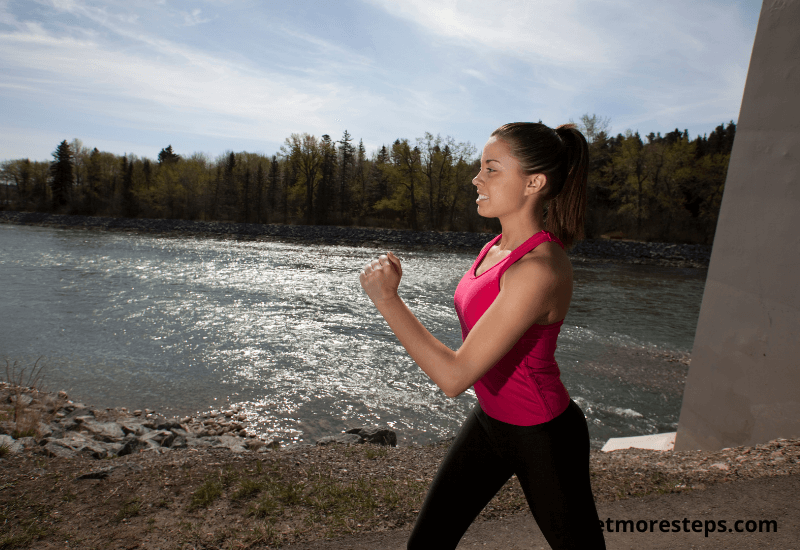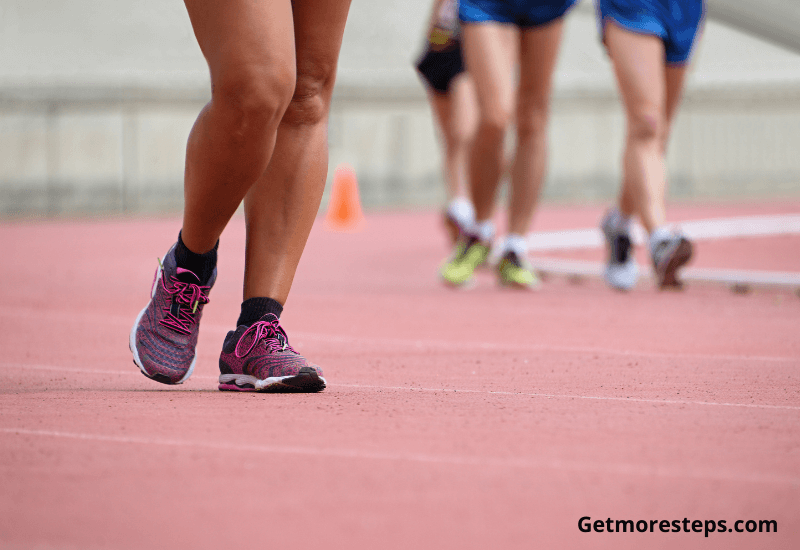Walking is a natural way of moving. From the moment we get up from bed, we walk, whether to take the dog for a walk, going shopping, or bringing our kids to the park. We do it so naturally that we don’t even think it could be a sport. But this natural movement that we often take for granted can actually turn into an endurance sport. And in this article, you’ll find out what is fitness walking and why it’s so good for health.
What is Fitness Walking
Contents
- 1 What is Fitness Walking
- 2 7 Proven Benefits of Fitness Walking
- 3 How Fast is Fitness Walking?
- 4 How to Start Fitness Walking?
- 5 Difference Between Fitness Walking and Race Walking
- 6 What Gear For Fitness Walking?
- 7 Is Fitness Walking Better Than Running?
- 8 What About Incline Walking?
- 9 Which part of your Body Work Most When Fitness Walking?
- 10 Conclusion
Fitness walking is, in fact, power walking. It’s considered a cardio workout, and if done correctly, it can make you burn lots of energy and improve your overall health. The quicker you walk, the more you’ll burn fat, and the more you’ll get fitter.
But to walk fast, you need to adopt the right fitness walking technique, and this can be done only by adopting the proper posture and pace. If you are already fit, fitness walking might not be sufficient to raise your heart rate into the fitness zone.
If this is the case, you may have to consider switching to racewalking, jogging, or running. Unlike hiking, fitness walking is practiced on flat terrains such as treadmills, parks, sidewalks, quays, stadiums, or even the beach.
7 Proven Benefits of Fitness Walking
There are endless benefits of fitness walking, and knowing some of them may inspire you to get started unless you are already into it. Below is a list of fitness benefits according to health studies.
- It tones your muscles, calves, bum, and thighs
- It makes you burn energy, and when accompanied by a healthy eating plan, it helps you lose weight quicker.
- It increases your fitness level capacity
- It makes you sleep better at night
- It lowers blood sugar and prevents diabetes
- It requires no equipment
- It helps reduce cholesterol.
There are other many benefits of fitness walking, but it would take the whole page to mention all of them and I am not exaggerating.
How Fast is Fitness Walking?
Fitness walking requires to walk at a fast pace. But depending on each individual’s weight, age, and goal, the speed can range from 5 km/hour( 3.11 mph) to 10km/hour (6.21 mph). A fitness walking session’s duration will vary between 35 minutes to several hours, depending on the walker’s fitness capacity. However, to get fitter and lose weight, it is recommended to walk 35 minutes at a minimum of 5km/hour (3.11 mph) at least 4 to 5 times a week. But if you are new to fitness walking, it’s suggested to start slowly and add more steps gradually.

How to Start Fitness Walking?
As fitness walking is a workout, you need to stretch or walk slowly for about 5 minutes to warm up your muscles when you begin and end your walking session with another 5 minutes of slow walk to cool down. This will prevent joint injuries and give you time to adjust your posture before starting your fitness walking session. Below are the steps to follow:
Upper Body Posture
- Keep your head up with your chin parallel to the ground.
- Keep your shoulders down and relaxed without pulling them back.
- Your back must be straight, not arched forward or backward.
- Make sure your eyes look forward, at least 20 feet ahead.
- Pull your abdominals in, but not too much so can still breeze. It allows you to keep a good posture.
Arms
- When walking, your arms should be bent at 90 degrees angle.
- Swing your arms forward and backward without crossing them in front of your body.
- Try not to bring your hands higher than your chest.
Feet
1.To walk efficiently, pay attention to your steps. So make sure you walk from your heel to the toe.
2.You must push off powerfully with your forefoot and your toe to propel you forward.
3.If you feel that your forefoot isn’t rolling properly and slaps the ground with each step, look for shoes that provide more flexibility under the foot’s ball. Usually, fitness walkers like to use running shoes.
Stride
1.Warm up by walking a few minutes slowly. This is extremely important.
2. Walk on your heel for a few meters to get used to the movement.
3. Start to walk naturally and push your foot further forward to increase the length of your steps. At the same time, increase your rotation in your hips.
4. Make sure your foot doesn’t go too far in front of the body.
5. Your stride should be longer behind your body rather than in front of your body.
Difference Between Fitness Walking and Race Walking
Fitness walking and racewalking seem similar at first glance, but both workouts are different in many ways. Race walking is a competitive Olympic sport, while fitness walking is an activity sportive. Race walking is more intense as it requires to walk faster. Fitness walking uses a technique of walking more quickly than regular walking to improve health and fitness. While the two activities use different walking techniques, both are an excellent form of workout to lose weight and improve health.
Race Walking Pace
In race walking, the pace can vary between 6 (9.65 kph) to 9 mph (14.5kph). The speed used in Fitness walking, as I said above, range between 3.11 mph ( 5kph) to 6.21 mph (10kph).
Race Walking Rules
There are specific rules in race walking that need to be considered. The first one is that one foot must maintain contact with the ground. Secondly, the knee needs to be straight until the leg passes under the body. A judge race can disqualify a race walker if they bend the knee, lean too much, use the wrong arm swing technique, or overstride.
Things to consider
Race walking is more difficult than power walking, but with good motivation and lots lots lots of training, you can become a race walker. Since race walking is more intensive than fitness walking, it burns two to three times more energy over the same amount of time. However, whether you opt for race walking or fitness walking, start slowly and gradually add more steps. Always begin with 5 minutes of light walking before you start your walking session. Another important thing to mention is to see your doctor and get permission to start with a new fitness program.
What Gear For Fitness Walking?
The movements of the body are more pronounced in fitness walking. The strides are longer and faster, and the motion is more supple. When doing fitness walking, your heel hits the ground first, then you roll through your heel to your toe, staying in contact with the ground.
This means you need shoes that provide good stability and cushioning from heel to toe. Your foot’s needs for fitness walking are different from other sports. Since walking shoes are heavier and often less flexible than running shoes, they are not recommended for fitness walking.
Most fitness walkers use running shoes because they are lighter and more flexible than walking shoes. Other than a good pair of shoes, motivation is the only thing you need.
Is Fitness Walking Better Than Running?
Both running and fitness walking provide the same benefits. But when it comes to burning energy, running is hands down the winner. If you want to lose weight more quickly, running might be a better choice for you – although fitness walking also helps lose weight.
However, if you aren’t very fit and don’t think you’ll be able to run, start with walking. And when you get in better shape, you can consider switching to jogging or running.
The good thing about fitness walking is that it’s easy to do; it’s a low-impact exercise; thus, it doesn’t put pressure on your joints as running does. Everyone can do fitness walking, and it does a great job of boosting your heart rate and improving health.
What About Incline Walking?
Walking uphill can make you burn more energy than running on flat terrains. But if you were to compare walking uphill to running uphill, then running takes it over. If you want to start with incline walking, you can do it by setting incline on your treadmill if you have one or find some hilly areas. But never forget to add intensity gradually. For instance, you could incline by 5, 10 to 15 percent at each seance of incline walking.
Which part of your Body Work Most When Fitness Walking?
Contrary to what many people think, fitness walking doesn’t just tone leg muscles but also other muscle groups. This includes the heart, arms, abdominals, and the back. In short, fitness walking is a complete sport! Fitness walking strengthens muscles and increases flexibility while improving posture. Since Fitness walking helps in relaxing and sleeping, it not only tones the muscles of your whole body but also gives you more energy.
The legs and thighs.
Fitness walking muscles: your glutes, calves, and thighs. How does fitness walking make these muscles work? This large muscle called quadriceps at the front of your thighs stretches your leg and bends the thigh at your hip.
At the back of your thigh is located the hamstring muscle group, which bends and rotates your knee and extends your femur when you walk. And each time you bend your legs, the hamstring muscles contract.
Your Glutes are the largest and one of the most powerful muscles in your body. The glutes act as stabilizers and help you stand upright, preventing you from falling. In inclines, the glutes contract and become toned, especially when fitness walking. Your calves help elongate your ankles and propel you forward.
Abdominals
As you speed up, your heart rate rises, making you breathe more intensively and, as a result, strengthens your abdominals without you realizing it. Additionally, your abdominals help keep your body balanced and protect your spine, and when you walk, you strengthen those muscles.
The Heart
Your heart is a cardiac muscle, and when practicing fitness walking, it becomes stronger, which helps it from working too hard to pump oxygen-rich blood through your body.
Upper Body
Fitness walking requires you to lengthen your stride and increase your pace (100-120 steps per minute), making your arm swing. This movement helps strengthen your upper body’s muscles as well as the back’s muscles. When practiced regularly, fitness walking helps keep your back healthy and strong, and it can even lower back pain.
Conclusion
To sum it up, fitness walking is one of the best forms of exercise. Not to mention, it’s easy, it doesn’t cost anything, and it can be practiced everywhere. The only thing you need is a good pair of walking shoes and motivation!
Do you practice fitness walking? If so, you are welcome to share your experience in the comments below.

I don’t know about you, but I love my feet because they allow me to walk and go wherever I want to go. Without them, I would be lost! So I always spoil them with a good pair of walking shoes to make sure they are as comfortable as possible. If you take care of your feet, they will take care of you and your health. Well, fitted shoes will protect them and allow you to get more steps without pain!
Read more about me



